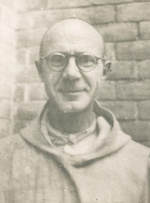|
3/9/2018 0 Comments VIVA CRISTO REY! 萬歲耶穌基督國王!At Teng Chia Yu, Father Alphonsus L’Heureux (b. 1894) had been separated from his confreres. A missionary with the Society of Jesus, he switched to the Trappist monastery late in life. A French Canadian, born in Coaticook, Quebec, he had once loved intensely a beautiful girl, Denise Dupuis, who had taught him how to folk dance. But he had held back his signs of affection, for he knew when it came time to make a decision, he would choose God.
Strong in body and will, when he worked in the fields he put all his heart and soul into it, and he could do the same work in one afternoon that three Chinese men did in two days. Strong in faith and will, as soon as he returned from the fields, without fail, he headed straight to the church for the Stations of the Cross, then kneeled before the altar of the Sacred Heart for contemplation. Every day, he went to the Sacrament of Penance. With that strength of will, he faced his interrogators and their taunts during the Death March. “Ha! If He’s a God who does not care to help you, or one who cannot help you, you can have Him,” guards taunted. “For our part, we don’t believe in God.” Backed with the scholarship of the pre-Vatican II Jesuits, Father Alphonsus refuted vigorously their arguments, for which he was brutally tortured, until he could only lie on the ground, in solitary confinement, barely alive, without a blanket or even a rag to cover his body in the cold. Suffering from dysentery, his feces, like white mucus, encrusted his trousers that were never removed or cleaned. When he lay dying, his hands, bound with steel wire behind his back since the trial on July 23, 1947, were finally freed. But the wrists had swelled, nearly unrecognizable with red, gaping wounds. Each resembled an opened, toothless mouth, screaming. On Friday, September 12, 1947, the Feast of the Most Holy Name of Mary, rain poured steadily in the village of Teng Chia Yu. Autumn, the most beautiful season in the Mongolian mountains, displayed the explosion of blood red from the Chinese maples dotting the landscape on the slopes. Father Alphonsus called out from his cell. Close by, in Father Sebastianus Pien’s cell, a young Red soldier, less cruel than the others, heard, but couldn’t understand the priest’s cries. “That foreigner is calling out. Go, and see what he wants,” the soldier told Father Sebastianus Pien, who approached and kneeled at the side of the dying priest. “I want this,” he said, raising his filthy, wounded right hand and painfully tracing with it the sign of the cross. Father Alphonsus wanted to make his confession. From his spot on the bare floor, in his soiled trousers, crawling with lice, he whispered his confession, and as he said his Act of Contrition, Father Sebastianus pronounced the absolution. “Amen,” Father Alphonsus said, himself, then asked for a cup of water. Between sips, he looked up and smiled. “In a short time, I will go to Heaven,” he said. “We will meet again in Heaven, then,” Father Sebastianus answered. “I shall die tomorrow – Mary’s day. I’ll be very happy to die. In Heaven, I shall pray for all of you. Be brave.” The young, Red soldier approached Father Alphonsus and said, “Old Father, are you still alive?” “I will die soon. I thank you for all you have done for me. You have been very good to me.” The next morning, Saturday, September 13, 1947, the cook brought food for Father Alphonsus. As he opened the door, he called to the priest. But there was no answer. When he touched the cold body, he knew he was dead. The young, Red soldier, less cruel than the others, approached the monks. In a reverential whisper, he described the priest’s death. “That man died very peacefully. He looked just like the other man in your figure-10 frame at Yang Kia Ping.” Instantly, the monks understood the profound meaning. In written Chinese, the character for the number 10 is an upright cross, which is referred to as a figure-10 frame. At Yang Kia Ping, where their abbey stood, the soldier had seen a crucifix. It was true. Brother Marcellus Chang, Father Sebastianus Pien and two other monks were ordered to bury the body of Father Alphonsus. As Brother Marcellus looked down, he saw that his dead confrere’s legs were crossed, with his shrunken right foot resting above the left. His hands, with bones sticking out at the wrists, were folded atop his breast. Upon his face, a peaceful, serene beauty. Looking upon the smiling face, Father Sebastianus thought, He does not look like a corpse, at all. The monks placed the body of Father Alphonsus upon a stretcher. Lifting the bier, the monks genuflected, praying in their hearts as they walked to a nearby mountain slope, where the reticent gravediggers began their sorrowful task far from the abbey, where they should have been celebrating the eternal life with the austere beauty of a Trappist burial. VIVA CRISTO REY! 萬歲耶穌基督國王!
0 Comments
Leave a Reply. |
AuthorTHERESA MARIE MOREAU is an award-winning reporter who covers Catholicism and Communism. Archives
October 2023
Categories |

 RSS Feed
RSS Feed